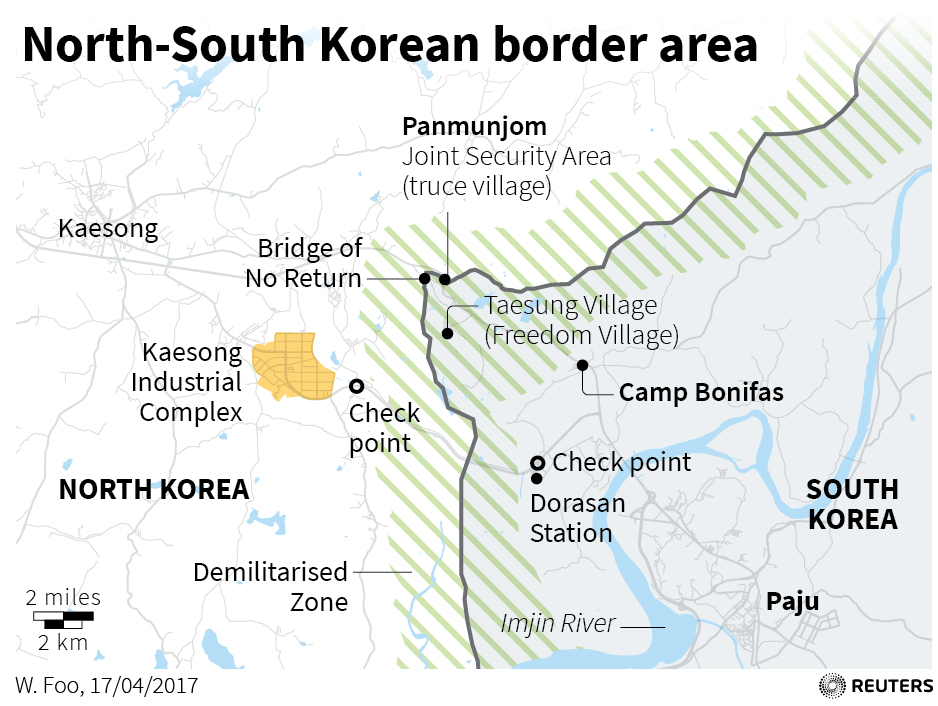
By Hyunjoo Jin and Haejin Choi
SEOUL (Reuters) – A half-hour’s drive north of Seoul, along a highway lined with barbed wire, lie two shopping malls the size of several football stadiums, a stone’s throw from the world’s most militarized border.
The malls are in the city of Paju, gateway to the U.N. truce village of Panmunjom, where military officers from the combatants of the 1950-53 Korean war discuss armistice matters — when the two sides are on speaking terms, which they aren’t these days.
“Fairy tales come true in Paju”, is the advertising lure from the Korean Tourism Board. But it was nightmares that were all too true here during the Korean war, when Paju featured some of its fiercest battles. Paju is home to the country’s only “enemy’s cemetery”, where the remains of Chinese and North Korean soldiers are buried.
That’s all but forgotten history now. On the rooftop of the Lotte Premium Outlet, children and their parents can view North Korea across the Imjin River through binoculars. The mall also features a merry-go-round, cinema, and a mini-train.
At Shinsegae Paju Premium Outlet, about a dozen children jump and scream around a fountain inside the mall on a sizzling, July summer day. Just a couple miles away is a village modeled after France’s tourism center of Provence, where restaurants, bakeries and clothing shops are decorated like a children’s playbook.
Elsewhere in Paju, kids carved wood to make Pinocchio dolls at a museum, while adults tasted wine made of meoru, a Korean wild grape, at a farm.
Paju, indeed, shows little signs of the tensions that have arisen since North Korea marked the U.S. July 4th holiday with a successful launch of what it said was an intercontinental ballistic missile. The missile test prompted the United States and South Korea this month to conduct air force bomber exercises in the skies near here.
LITTERING LAND MINES
But at Paju’s Provence Village, Kim Ki-deok, a 41-year-old office worker from south of Seoul and father of a 4-year-old boy, said he doesn’t feel any more danger from being close to the border.
“If North Korea really wants, they can shoot missiles far away,” said Kim. “I feel refreshed and would like to come here again.”
The sense of insouciance can even be seen at the U.S. military’s Camp Bonifas on the outskirts of town, home to a three-hole golf course that Sports Illustrated once called the “world most dangerous golf course” because of the Korean War vintage land mines littering the area.
The Korean War, in which the United States fought alongside South Korea and China with the North, ended in a truce that has yet to be replaced by a peace agreement and has left the two sides technically at war.
It means South Koreans have long grown accustomed to living in a doomsday scenario, one that includes up to 10,000 artillery guns pointed toward the South and capable at any moment, in the words of North Korea’s propaganda machine, of turning Seoul into a “sea of fire” and a “pile of ashes.”
For 30-year-old Park Chol-min, it’s nothing more than empty threats.
“It’s just a show or performance. I think North Korea has a lot more to lose than to gain by turning Seoul into a sea of fire,” said the video game producer from Seoul, visiting the Shinsegae mall with his girlfriend to buy her a birthday gift.
DEFENSE MECHANISM
Paju stepped up North Korea-related tourism in the 2000s, when liberal governments launched a “Sunshine Policy” of engagement with North Korea. Foreigners and locals flocked to Panmunjom to see stony-faced North Korean soldiers on guard and an underground tunnel built by the North, and to Imjingak, which houses the Bridge of Freedom, where prisoners of war were traded at the end of the war.
The tourism push took a huge leap late in 2011, when two massive premium outlets run by South Korean retail giants Shinsegae and Lotte opened. More than 12 million visitors went to the two malls last year — more than Seoul’s population of 10 million.
It was not long after the malls opened, though, when North Korea dramatically stepped up the pace of missile and nuclear tests under Kim Jong Un, who took power in Pyongyang when his father Kim Jong-il died in December 2011.
“The tests have not dented visitor interest at all,” said a Paju city official in charge of tourism, who asked not to be named. “It has become just part of a daily life, although it is sad to say so.”
Normalizing the North Korean threat is part of a “defense mechanism” for South Koreans, says Kwak Keum-joo, a psychology professor at Seoul National University.
“I feel anxious about North Korea when I travel overseas. Once I return to Korea, I forget it,” Kwak said.
That’s not so easy for 74-year-old Woo Jong-il, who lives in a small village of Manu-ri, just south of the Imjin river that divides the two Koreas.
Woo built a bunker in his backyard, one of several residents in Manu-ri who did so in the early 1970s, when bullets fired from North Korea wounded several in his village and damaged a house next door.
“I don’t think this is obsolete even now,” he said, showing a visitor around a dark basement shelter just big enough to accommodate his seven family members.
“I feel anxious. How can I not be? We are at the front so we can be victims. If the relationship with the North worsens anytime, this bunker makes me feel safe.”
(Additional reporting by Heekyong Yang,; Editing by Soyoung Kim and Bill Tarrant)
